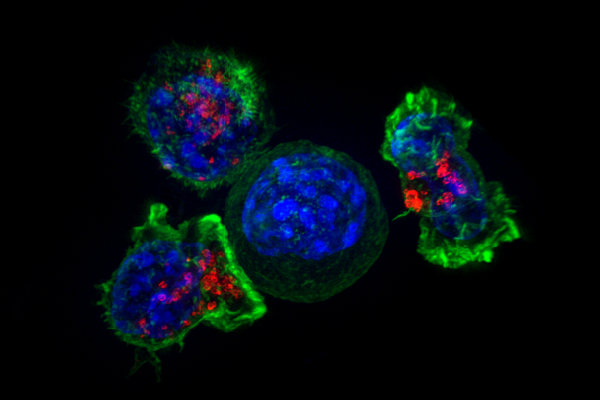New strategy for cancer therapy spells double trouble for tumors

Scientists at Scripps Research have uncovered a new strategy to kill tumors, including some triple-negative breast cancers, without harming healthy cells, a discovery that could lead to more ways to treat tumors while reducing side effects.
The study, published recently in Nature Communications, shows that a molecule in cells, called Rad52, repairs special kinds of damaged DNA that accumulate in some cancers. A future therapeutic could inhibit Rad52, robbing cancer cells of this repair mechanism.
"This could give us a way to kill tumors without harming normal cells," says Xiaohua Wu, Ph.D., professor at Scripps Research and senior author of the study. "That's the future. That's the goal for targeted cancer treatments—to make these treatments a part of precision medicine."
Wu and her colleagues investigate how seemingly healthy cells become cancerous, with an eye toward leveraging differences between cancers and healthy cells to develop new therapeutic approaches. The culprits may be different from patient to patient, so the key to killing specific cancer types is to study the basic roles of proteins—and how things go awry in different cancers.
"The most important thing is to understand the defects in all these tumors, and then you can understand how to target them specifically," says Wu.
One cancer subtype is triple-negative breast cancer, which make up 10 to 20 percent of breast cancer diagnoses. This aggressive form strikes an estimated 28,000 Americans each year.
The new research shows how to exploit a weakness in some triple-negative breast cancers. Some of these tumors have a deficient version of the gene that codes for a protein called FANCM. Normally, this protein protects regions of DNA called common fragile sites, which are prone to breaking when cells divide.
Wu's team found that FANCM-deficient tumors have to call in a backup team to repair DNA. That's when the protein Rad52 steps in to repair DNA damage in these tumors. This finding came as a surprise because Rad52 plays no essential role in healthy cells.
Next, the researchers tested what would happen if they stopped Rad52 from working in FANCM-deficient cells. As they suspected, the cells accumulated double-strand breaks at common fragile sites. With no way to repair these breaks, the cells died. Follow-up experiments in a mouse model showed that suppressing Rad52 in FANCM tumors dramatically reduced cell and tumor growth.
This phenomenon, when a cell only dies because of a combination of two defects, is called synthetic lethality. Only cells with both defects will die. This means drugs inhibiting Rad52 would not harm healthy cells, which do have sufficient FANCM. Only FANCM-deficient cells, like those seen in some triple-negative breast cancers, would die.
"Normal cells are fine when you remove Rad52, so we think potential therapies would have a very low toxicity," Wu says.
Exploiting synthetic lethality is emerging as a crucial strategy in cancer drug design. In fact, the U.S. Food and Drug Administration recently approved several drugs called PARP inhibitors, which also take advantage of synthetic lethality to kill tumors with BRCA mutations.
Wu says the next step in this project is to develop potent small molecule inhibitors of Rad52 that could be tested as a drug candidate for a new targeted cancer therapy. "This study shows why it's very important to focus on basic research and then follow-up on findings that can benefit patients," Wu says.
More information: Hailong Wang et al, The concerted roles of FANCM and Rad52 in the protection of common fragile sites, Nature Communications (2018). DOI: 10.1038/s41467-018-05066-y



















